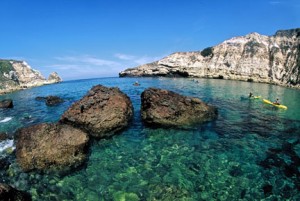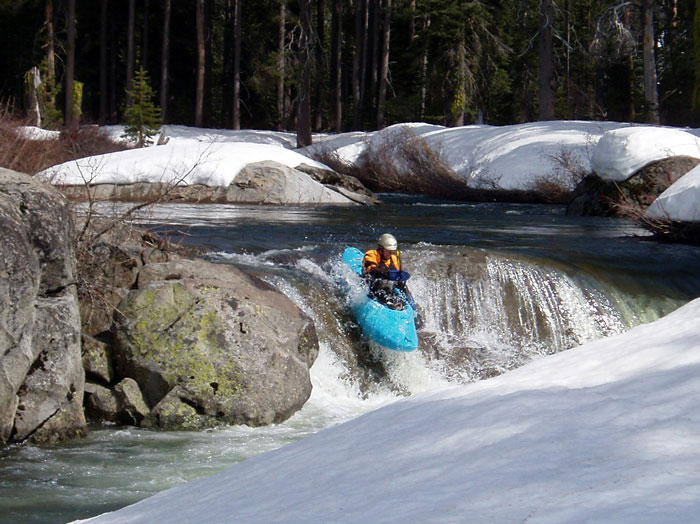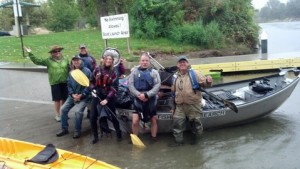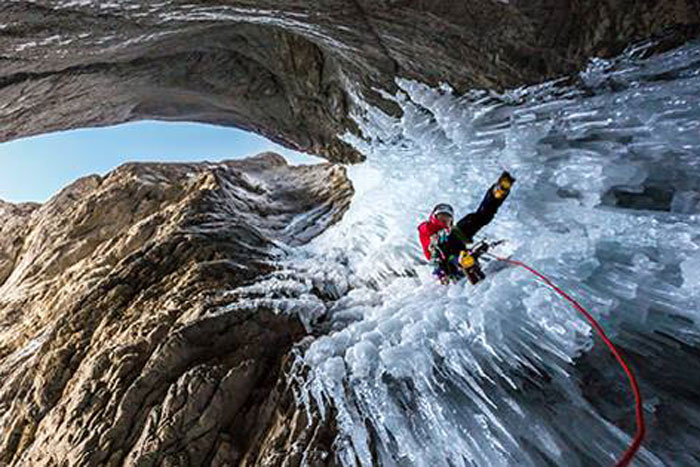- Tahoe’s Nevada Beach Tops the List of Hard-to-Book Campgrounds - 07/17/2024
- Cannabis Watershed Protection Program Cleans Up Illegal Grow Sites - 07/10/2024
- French Fire - 07/05/2024

A group of kayakers inside Potato Harbor, Santa Cruz Island.
Kayak touring Channel Islands National Park, ‘Galapagos North,’ is like a trip back in time to untouched California
Story and photos by Chuck Graham
I stepped off the Island Packers ferry onto the sturdy dock at Prisoners Harbor, primed for a hilly, 13-mile trail run back to my kayak and campsite at Scorpion Anchorage located at the southeast end of Santa Cruz Island.
The largest of California’s Channel Islands at over 60,000 acres and part of Channel Islands National Park, the mountainous island is also the most unique with flora and fauna found nowhere else on earth.
I was running then paddling in what is also known as “the Galapagos Islands of the north,” a archipelago that’s close to the mainland of teaming Southern California, yet worlds apart in biodiversity and population — only about 30,000 people a year step on the islands.
Once I reached the narrow spine of Montanon Ridge my legs were burning, the ocean beckoning three miles below. The island’s highest peaks rise more than 2000 feet.
I opened up my stride and followed an old, rutted ranching road descending swiftly into the broad mouth of Scorpion Canyon. Clever ravens croaked and a peregrine falcon buzzed the cliffs scattering flocks of western gulls into hysteria.
A tiny, housecat-sized island fox had beat me to the kayaks and foraged through the empty boats for food.
It was time to cool down. A quick dunk in the cobalt blue water and I was off paddling in and out of the honeycombed cliffs of Santa Cruz, sampling the many sea grottos along the wave-battered cliffs.
San Miguel Channel ‘Tossing’
Sitting just off the coast of Santa Barbara and Ventura Counties, the volcanic island chain is one of the best kayaking locales in the world, littered with sea caves and beautiful camp spots, and traversed by winding trails that invite hikers and runners to explore.
I was on a 10-day solo circumnavigation of the four northern islands of the five islands in the national park — Santa Cruz, Santa Rosa and San Miguel, often referred to as the outer islands, and Anacapa, closest to the mainland. The fifth, tinySanta Barbara Island, is isolated many ocean miles to the south, off the coast of Los Angeles, closer to Catalina Island.
After three balmy days on windswept San Miguel Island, which sticks furthest out into the Pacific, I made a dash for Santa Rosa Island, paddling three miles eastward aided by 25-knot northwest winds whipping up the channel. (Santa Rosa is 46 miles offshore from Ventura.)
Swell was building from the south and steady out of the northwest, colliding in the channel like mighty titans, enhanced by those perpetual winds sweeping down off Point Conception on the mainland north of Santa Barbara.
Halfway across the turbulent channel, the seas grew larger and the winds intensified, and before reaching the safety of an anchored kelp forest I capsized in the frothing cold water.
A yard sale ensued as some of my gear bobbed in the chop while I scrambled back into my sit-on-top kayak. After retrieving my last dry bag I made a beeline for the undersea canopy of kelp. It forced the wind to lie down, a much needed reprieve from the challenging conditions.
Santa Rosa Encounters
Several northern elephant seals, migrants from the Aleutian Islands, were hauled out at Sandy Point on the western tip of Santa Rosa. Flipping dry sand on their massive backs, elephant seals are ungainly on land. But in the ocean they are superior deep-sea divers, routinely diving to depths of 3,000 feet or more and able to hold their breath for more than 90 minutes.
Overall, elephant seals spend 80 percent of their lives at sea. On San Miguel and Santa Rosa islands, they haul out to enjoy a carefree California beach vacation in a habitat that is much as it was 200 years ago.
Paddling 18 miles to the east along the northern shore of Santa Rosa, I rounded the daunting cliffs at Carrington Point and entered Bechers Bay. California sea lion bulls bellowed as a throng of seabirds enjoyed the bounty of fish schooling in the swirling currents at the eastern tip of the second largest of the Channel Islands (53,000 acres).
That night I slept soundly atop a picnic table in the campground at Water Canyon. The only other occupant was an inquisitive spotted skunk. Its padded feet stomped along the bench of the picnic table. Under a star-filled night, I flipped on my headlamp. I leaned over and was literally nose to whiskers with the mostly nocturnal critter.
Luckily, it did not feel threatened or I would have been a sleeping duck for a very unpleasant face shot.
Early the next morning, I went for a quick run through Cherry Canyon, rested legs feeling fresh after my long day of kayaking the day before. Island oaks, manzanita, buckwheat and blue dicks choked the narrow canyon leading down toward Bechers Bay.
As the crescent moon-shaped cove unfolded before me, I caught a glimpse of a misty plume released from the spout of a lone whale. The plume was bearing west, the cetacean no doubt chasing a bait ball into the open ocean.
Anacapa Showdown
Anacapa Island, closest to the mainland, possesses some of the best paddling within the entire national park. The small, narrow island actually consists of three islets (East, Middle and West Islands) nearly five miles long.
The island has a high concentration of arches to paddle under, an array of sea caves to explore, and spindly pinnacles of volcanic rock jutting 20 feet high, where brown pelicans and cormorants perch and preen and black oystercatchers forage at their base. There are also a couple thousand raucous California sea lions congregating around the southeast end.
Normally you don’t see too many big sea lion bulls at Anacapa. You’ll find them brawling over females and territory on remote sections of Santa Barbara and San Miguel Islands.
But on this occasion, near the end of my 10-day solo circumnavigation of the islands, there was one big brute sharing a crag with some western gulls and Brandt’s cormorants in Cathedral Cove.
As I paddled out of a sea cave in the cove, the bull locked onto me like a torpedo. Snorting, barking and heaving from the neck up, the burly sea lion cut a swath through the dark waters straight for me.
“Should I try and get a photo before he lands in my lap?” I thought.
Territorial bulls will challenge intruders if their space has been breached. Most charges are of the bluff variety, but this pinniped seemed serious.
I envisioned it breaching and landing on the bow of my kayak catapulting me and my gear into the water, leaving me exposed to gnashing teeth and its thrashing girth, my precious gear sinking to the bottom.
I quickly stashed the camera away in my dry bag.
Gratefully, the hotheaded bull was defused when a pair of female sea lions entered the fray, quickly diverting his attention away from me. A deep sigh of relief, several quick strokes, one look over my shoulder, and I could’ve sworn one of those females winked at me.
_______________________________________________________________
Chuck Graham is a writer, photographer and kayak guide for the Channel Islands based in Carpinteria on the Central Coast. His stories and photos have appeared in Canoe & Kayak Sea Kayaker, Trail Runner, Backpacker, Men’s Journal, Outdoor Photographer and Patago- nia catalogs.













